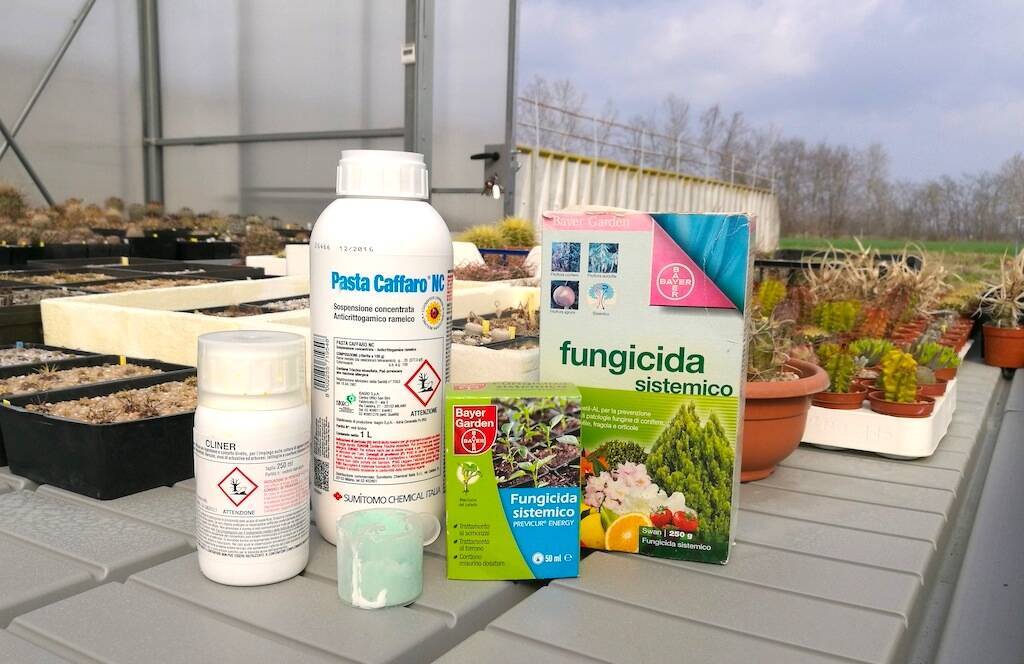As much care as we can give to our cacti and succulent plants, some drawbacks with parasites, pests, infections and fungi can always happen. Unfortunately, it must be considered, particularly if you have many plants. With proper cultivation, however, the problem can be significantly reduced and the number of losses caused by animal parasites and bacteria can be considerably reduced. It may seem obvious, but the first and most effective tool for the fight against pathogens and harmful insects is prevention. Prevention is done through a cultivation regime as natural as possible that respects the cycles and times of plants without forcing their growth. Just in this way cacti and succulents grow healthy and robust to the point of being able to cope with adversities on their own. In the last few years, thanks to natural cultivation and treatments based on pesticides reduced to a minimum, I have no longer observed any attack on my plants by animal parasites. Sometimes I may have some losses due to Fusarium, but they are single specimens, never large scale infestations.
In the following article, we will see in detail what consists of prevention; which are the pests and diseases that can affect cacti and succulents; such as the symptoms of their action on plants, and how to carry out treatment and care in case of problems. (…)
The importance of air recirculation
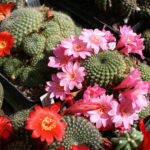
The keyword for prevention is air. Air, air and more air. Therefore, airing the environments in which we keep our plants and, consequently, keep humidity rates low. Open greenhouses as much as possible throughout the period from spring to autumn, fans for air recirculation, outdoor cultivation, are all important factors to give our plants the right amount of air. Also, of course, to the use of correct substrates, draining and low humidity, plenty of light and the right fertilization regimes (an excess of nitrogen, for example, forces the growth of succulents and makes them weaker in the face of adversities), proper irrigation and, more generally, cleaning (of soil, pots, tools and instruments, etc.).
Check the plants
A good practice consists, first of all, in observing the plants carefully before their purchase, discarding those suffering, clearly attacked by parasites (such as cochineal, easily recognizable by the naked eye) or deformed at the apex due to the attack of some aphids. Once purchased the plant, it is good to flake it and thoroughly clean the roots (especially if the plant is in peat), checking the condition carefully and repot in suitable soil. Another useful trick is to immediately isolate the plant or plants that we observe in distress or on which we detect the presence of mites (for example the red spider, see below) or parasites such as cochineal. Even more important is to isolate from other plants those subject to fungal attacks: the spores can quickly pass from one specimen to another and cause real disasters. All plants, then, must periodically be checked carefully to identify any problems and isolate the affected specimens to treat them with specific products and avoid that fungi and parasites may affect other plants.
Preventive treatments
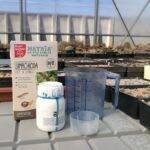
Preventive treatments can be useful against fungi and parasites, especially in two specific moments: in autumn and just before the beginning of spring. It is at these times of the year, in fact, that the combination of ambient temperature and humidity, in addition to the low activity of the plants, can favour conditions suitable for the proliferation of mites and bacteria. Before the plants go into stasis, at the end of summer/early autumn, two nebulisations at a distance of 15 days from each other with water and copper oxychloride, possibly combined with sulfur, will protect plants from some types of fungi and bacteria during the winter. In the same way, a couple of nebulisations at the beginning of spring, before watering, will contribute to the prevention at a time when temperatures tend to rise and, with them, the humidity rate due to the March/April rains. Against bacteria in the soil and root parasites, it is possible to carry out systemic treatments, i.e. special products mixed with watering water. Even in these cases, a treatment at the end of summer and one in spring, with the first watering, can be useful for preventive purposes. In these cases, it is possible to use systemic fungicides against radical rot (Previcur can be used against collar rot, while Tebuconazole can be used against fusarium and Propamocarb can be used for a wider spectrum defence). If the fusarium has already attacked the plant, it is advisable to throw away everything: plant, pot and earth.
An excellent choice, respectful of the environment and our health, is to focus on products with low environmental impact, like Neem oil, useful against infestations by mites and parasites. Always remember that chemicals, whether pesticides or fungicides, should be treated with great caution, wearing gloves and masks, as they can be harmful to health if inhaled or in contact with skin (in fact the use of many products is regulated by law and for the purchase and use of some of them, specific patents are required). An interesting alternative to chemicals against insects and pests can be to use natural remedies based on garlic and tobacco.
Some treatment, always for preventive purposes, can be done by nebulization or by the systemic way (i.e. through watering, so that the plant absorbs the product, which will go from roots to stem) even during the growing season. However, if the plants are healthy and robust, the treatments at the end of summer and the end of winter will be enough and the plants will become stronger and will be able to face and solve any problems.
Plant parasites
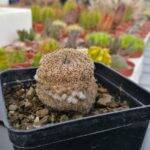
Plants can be attacked by plant parasites or pests. The first group includes fungi, bacteria, viruses and microplasmas. Fungi and bacteria, in particular, proliferate in the soil in conditions of heat and prolonged humidity. These are, probably, the most insidious and difficult adversities to face. This happens mainly because the presence of plant parasites is manifested only through the symptoms of the disease that they cause to the plant. In other words, fungi, viruses and bacteria cannot be seen with the naked eye, but you can see the effect of their harmful action. Unfortunately, when we realise it, it is almost always too late to save the plant.
Fusarium – It is the case, for example, of Fusariosis, caused by Fusarium oxysporum, a fungus present in the soil that causes withering, dry rot and the rapid decay of the plant, which first slows down the vegetation and then stains and then literally withers and dies. In the acute form, the Fusarium causes the basal rot of the affected subject, while in the slow form it causes a chronic infection that causes secretion and suberification of the plant, which slowly dies. Against this pathology, there is usually little or nothing to do, except try to deal with specific systemic fungicides (based on the above-mentioned Tebuconazole, for example). Of fundamental importance is to move the affected plant away from the others and, in case it is too late to save it, throw away plant, soil and pot (unless you want to disinfect it with bleach).
Root and collar rots – They are caused by fungi in persistent hot/damp conditions and by water stagnations in the soil. They affect the roots of the plants and extend to the collar causing their rot and, consequently, the death of the plant. If taken in time, for example after having noticed a slowing in the growth of the plant and its deterioration, you can intervene by flaking the specimen, removing all the old soil and cutting off all the rotten roots and then let the plant dry for at least a couple of weeks in the air but not in the sun. If the rot has hit the collar, you can try a rescue by cutting the plant to the healthy part (i.e. until the pulp is white and has no dots or brown areas). It is essential to use a sharp cutter by disinfecting the blade with alcohol before each cut, to avoid infecting the healthy part. Also in this case, after this operation, you will have to leave the plant in a shaded but very ventilated place for some weeks, until the cut part is completely dry and scarred. At that point, you can place the plant on pumice to try to promote the rooting of the cutting.
Pythium – It is a fungus that attacks the seedlings bringing the roots and the collar to rot. If it is not too late to intervene, the plants should be flared, the old soil removed and the seedlings left to dry. Afterwards, it is possible to use a fungicide based on Previcur, both for preventive and curative purposes.
Powdery mildew – This is another pathology caused by fungi, commonly called powdery mildew. It develops in conditions of low humidity and temperatures above 20 degrees and spreads through the spores carried by the wind. It reveals with white/greyish pulverulent spots, which lead to the decay of the plant. Against powdery mildew can be useful nebulizations with water mixed with sulfur.
Sooty Mould – Also the sooty mould is caused by fungi, a pathology that leads to the production of a dark-coloured crust or to the formation of black powder, often on cacti areoles, at the base of thorns. Are affected by it some cacti, like Ferocactus, which produce honeydew, nectar secreted by the areoles. In case of smoke, it is possible to intervene with copper sulfur, either by spraying or manually, by cleaning the affected areas with a toothbrush or a cotton bud soaked in a solution based on water, sulphur and copper.
Rust – This name indicates a pathology, septoria, caused by a fungus called septoria. The symptoms are yellowish spots on the stem, more or less extended depending on the severity of the attack. They are created in conditions of poor ventilation and stagnant humidity. The rust seems to particularly affect Ferocactus latispinus during the winter. It can be controlled by providing the plants with maximum ventilation and low humidity. In case of attack it is good to move the affected plants, give them more air and intervene with copper-based products.
Botrytis – Botrytis cinerea, also known as “grey mould”, is caused by a fungus in conditions of persistent humidity and poor aeration. It creates spots initially dark green with yellowish edges. Then the spots are darker until they become brown or black and are covered with grey mould. The best prevention is a good recirculation of air and space between one plant and another. In case of an attack by botrytis, it can intervene with systemic fungicides in association with copper oxychloride. Isolate the affected plant immediately to prevent the spores from passing on to other specimens.
Animal parasites
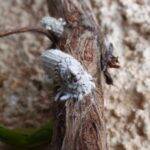
Even against animal parasites, the best weapon remains prevention, understood as proper cultivation aimed at obtaining robust and healthy specimens. However, some bad encounters between our plants and some parasites (or lice, as they are commonly called) can always happen.
Cochineal – These insects are among the main enemies of succulent. They attack plants like the Opuntia, but they do not disdain the other Cactaceae. They can be of three types: waxy cochineal, mealybugs and shield. They usually strike the apex of the plants, but they can nest, also between the roots when the soil remains dry for long periods. In the latter case, the attack is more dangerous, because we only notice it when we repot or if we are very careful if we see that the plant has blocked the growth and is declining without any other apparent causes. The mealybugs suck the sap from the succulents, weakening them, and compromising their growth. The waxy cochineal nestles between the coasts of the Cactaceae or around the areoles, is a couple of millimetres long and secretes a layer of wax. The cotton cochineal, as its name says, produces small white woolly balls. It threatens the apex of the cacti or between the leaves of the succulents and sucks the sap. If the infestation is limited, you can manually remove the mealybugs or crush them with a toothpick. In the case of root cochineal, it is necessary to remove the soil, clean the roots thoroughly, shorten them and, immerse the root system or the whole plant for a few minutes in a contact insecticide and then let to dry for a few days before repotting in the new soil. The cochineal shield is more difficult to remove manually, which also reproduces quickly and, if left to do, can literally cover the plant seriously compromising its growth until it decays. It clings tenaciously to the trunk of the cacti, is white/greyish and has the typical shield shape. They can be removed with a toothbrush, or removed with a nail, but it is not always an easy action. Specific systemic insecticides, or summer mineral oil, can be used against mealybugs. It is also useful alcohol (diluted in water and nebulized), which dissolves the waxy protection produced by these insects and makes them more vulnerable to a subsequent treatment based on specific products. In case of radical cochineal, it is good to immerse the roots (or the entire plant) for a few minutes in a solution based on water and specific anti-cochineal products. When crushed, the cotton cochineals produce a red substance that was used as a textiles dye by Mexican populations.
Red spider – This is a small phytophagous mite (Tetranychus urticae), not visible to the naked eye. It proliferates in dry, warm conditions, so it can develop in the hot season if the waterings are very spaced, and the climate is particularly dry. It strikes the apex of the cacti, where the tissues are more tender, and causes secretion on the epidermis which assumes a grey/reddish colour. Growing up, the stem is chapped and aesthetically compromised. At the same time, a massive attack by the red spider can slow the growth of the plant and compromise its proper development. Good prevention against these mites consists in the cultivation of cacti in full sun so that the epidermis hardens and is less subject to the attack of the red spider. At the same time, outdoor cultivation encourages the presence of insects competitors able to contain the development of this mite. A red spider infestation can be countered by systemic and acaricide insecticides such as kelthane, dicofol and sulfur products. It is important not to use the same active ingredient often because the red spider quickly develops acaricide-resistant strains.
Nematodes – They look like little worms. They develop in fresh and humid soils and can penetrate inside the roots of the plants blocking the lymphatic flow and leading the plant to growth block, decay and death. They can be easily noticed only in case of repotting: the roots have swellings, nodules a few millimetres in size. As a preventive measure, it is advisable to take a good look at the roots of freshly purchased plants or during each repotting. In the presence of nematodes it is necessary to cut the roots as much as possible and throw the pot and all the old potting soil. Some growers recommend soaking the roots for about twenty minutes in water at 50°. When you notice the presence of these nematodes, often it is too late because they move from one root to another and eradicating them is quite difficult. It is not by chance that several experts advise throwing away the plant in case of an attack by nematodes.
Aphids – Fortunately, they do not frequently attack succulents. These are green or black insects that can weaken the affected plants by opening the door to viruses. Specific products (such as Movento) are easily found against aphids, although they can be removed with soapy water (for example, using a Marseille soap diluted in water).
Metcalfa – They are small white or pale green insects and appear from the middle of May. They suck the sap of the plants and can facilitate the onset of honeydew and soot. They can be counteracted with specific insecticides, such as those used against cochineal.
Thrips – They are very small so that it is almost impossible to see them with the naked eye. They usually attack the flowers, attracted by the pollen, causing dryness, malformation to the petals and favouring the attack by viruses. Against these insects, you can use blue chromotropic traps, or Marseille soap and water or specific insecticides (dimethoate).
Swarming Fly – The larvae of these Dipterans are dangerous for seedlings. In fact, they nest in the soil and attack the collar and the roots of the young plants, causing their decay and subsequently their death. The swarming fly is attracted by humid soils rich of organic substance (e.g. peat); for this reason, it can easily attack the seeds, which for the first months must have the soil always humid. The larvae of swarming fly are fought with specific insecticides to be administered together with the waterings.
Snails and ants – Among the potential enemies of cacti and succulents there are also snails and ants. Snails can cause considerable damage because they eat the fleshy leaves of succulents and can attack the apical part of cacti, which is more tender. When they are found, they must be immediately removed from the plants, whilst to keep them away, we can resort to the old system of the saucer with some beer, which attracts them and the stuns. There are also specific products in granules to be spread on the surface of the substrate: for snails, they are toxic and eliminate the problem before the molluscs attack the plants.
Ants are not dangerous, but they steal the seeds of succulents and are attracted to the nectar that the glands of some cacti produce (e.g., Ferocactus). They can also carry insect eggs that are harmful to plants. They contrast with specific insecticides, often powdered, to be spread around pots to keep them away.
Wondering what is the right soil for cacti and succulent plants? You can read here…
SUBSCRIBE TO THE SITE – If you liked this article, subscribe to the site to have access to all the contents for one year or three months depending on the formula you choose. Here you will find terms and conditions.
SUBSCRIBE TO THE NEWSLETTER – If you want to receive the free newsletter every time new content is published, fill in the fields at this link!
Correlated articles
Cactus cultivation cards
How to repot cacti and succulent plants
Substrates for cacti and succulents
The correct soil: the materials you can use
© The texts, videos, photos and graphic elaborations of the site “Il fiore tra le spine” are original material and are covered by copyright. It’s forbidden to reproduce them in any way.


